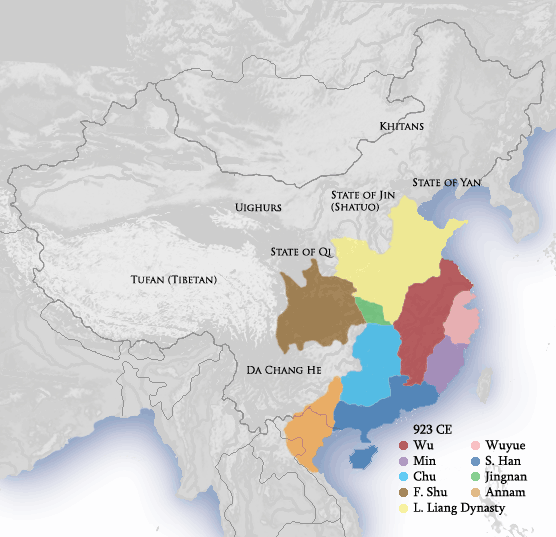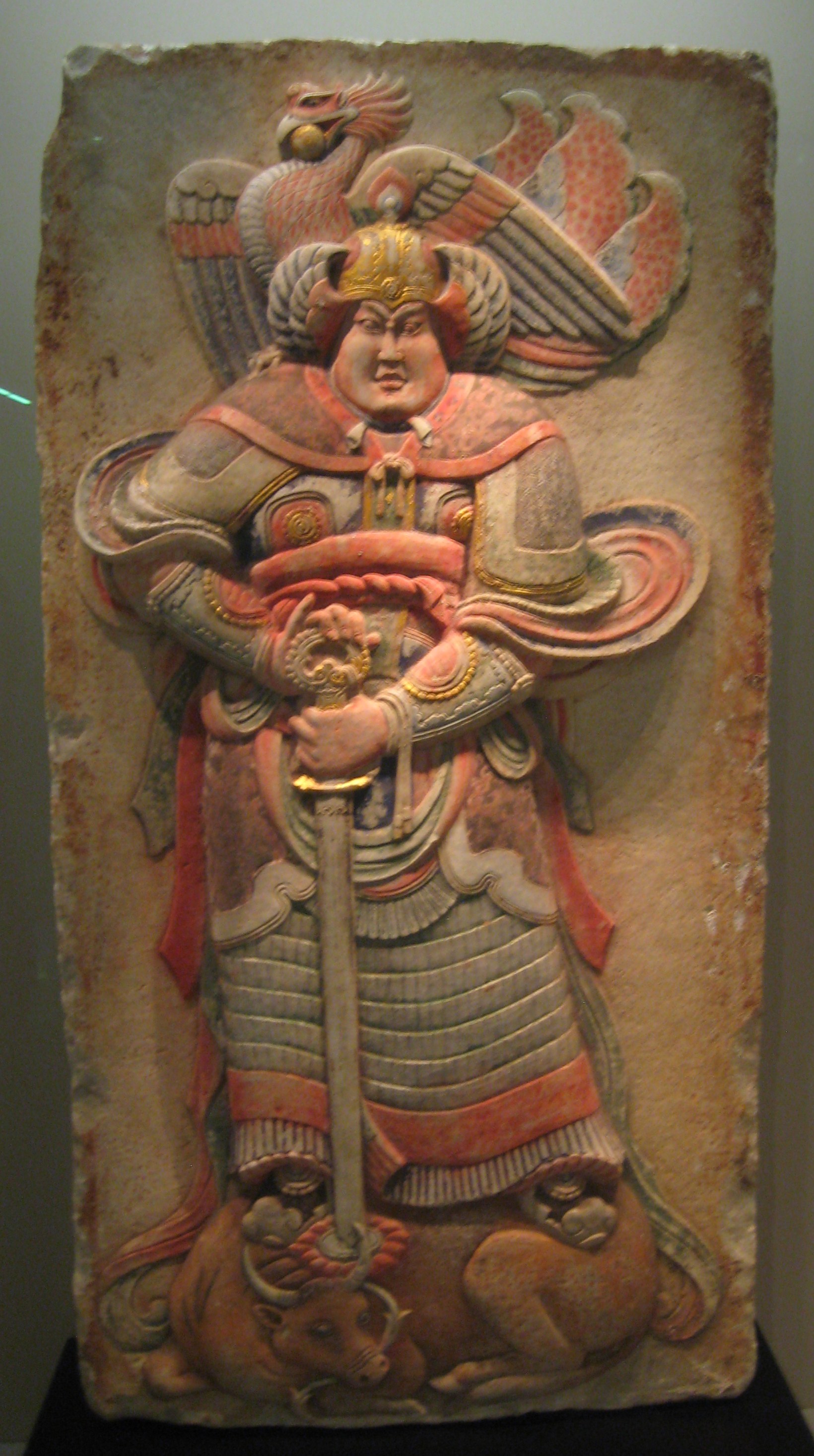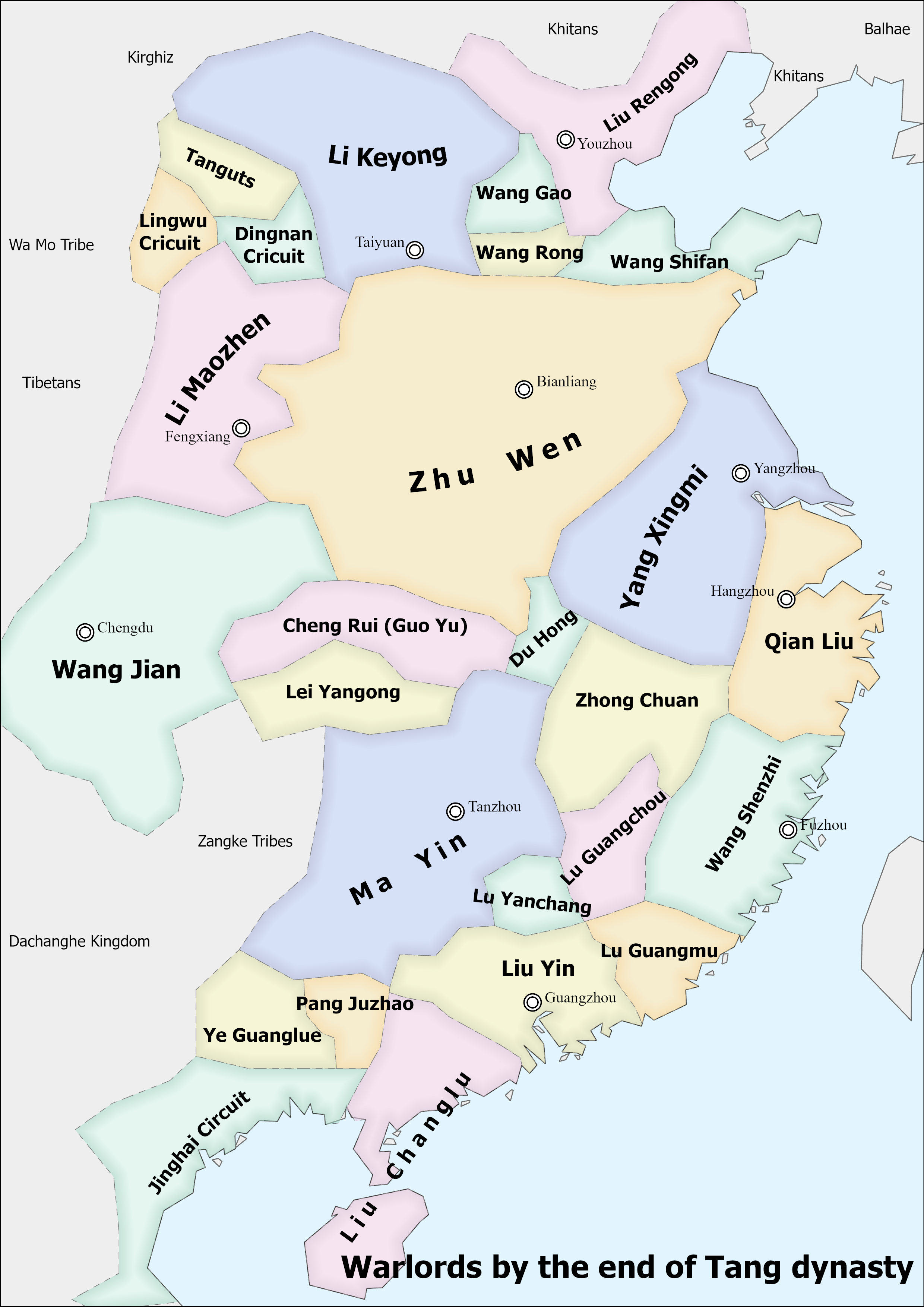|
Ngô Dynasty
The Ngô dynasty (; Chữ Nôm: 茹吳), officially Tĩnh Hải quân (chữ Hán: 靜海軍), was a semi-independent Vietnamese dynasty from 939 to 968. The dynasty was founded by Ngô Quyền, who led the Vietnamese forces in the Battle of Bạch Đằng River against the Chinese Southern Han dynasty in 938. Around 930, as Ngô Quyền rose to power, northern Vietnam was militarily occupied by the Southern Han and was treated as an autonomous province and vassal state of the Later Tang Dynasty, referred to as Tĩnh Hải quân. Every year the Jiedushi of Tĩnh Hải quân had to pay tribute to its Chinese master in exchange for peace and political support. At the beginning of the 10th century, China was domestically plagued and weakened by civil war during what is known as the Five Dynasties and Ten Kingdoms period. The Chinese were preoccupied with these civil struggles and lost their grip on Tĩnh Hải quân periodically. Tĩnh Hải quân took advantage of this opport ... [...More Info...] [...Related Items...] OR: [Wikipedia] [Google] [Baidu] |
Tĩnh Hải Quân
Tĩnh Hải quân or Jinghai Circuit ( Chinese: 靜海軍, pinyin: Jìnghǎi Jūn) (literally "Peaceful Sea Army"), also known as Annan or An Nam (), was an administrative division of the Tang dynasty of China administered by Chinese governors, which then later became a quasi-independent regime ruled by successive local Vietnamese warlords and monarchs. It was centered around what is now northern Vietnam from 866 to 967 during the late Tang period and lasted until the late Five Dynasties and Ten Kingdoms period when Đinh Bộ Lĩnh established the Đinh dynasty. History Chinese period Jinghai Circuit (Tĩnh Hải quân) was created in 866 by the Chinese general Gao Pian as a Tang '' fanzhen'' ("buffer town") in the former Annan Duhufu (Protectorate General to Pacify the South) after retaking it from Nanzhao, which had invaded and captured the area in 863. The area of the command was sometimes referred to as "circuit" (道 dao). In 875, the Huang Chao rebellion broke ou ... [...More Info...] [...Related Items...] OR: [Wikipedia] [Google] [Baidu] |
Southern Han
Southern Han ( zh , t = 南漢 , p = Nán Hàn , j=Naam4 Hon3; 917–971), officially Han ( zh , t = 漢 , links=no), originally Yue ( zh , c = 越 , links=no), was a dynastic state of China and one of the Ten Kingdoms that existed during the Five Dynasties and Ten Kingdoms period. It was located on China's southern coast, controlling modern Guangdong and Guangxi. The dynasty greatly expanded its capital Xingwang Fu ( zh , t = 興王府 , p = Xìngwáng Fǔ , links=no, j=Hing1wong4 Fu2, present-day Guangzhou). It attempted but failed to annex the autonomous polity of Jinghai, which was controlled by the Vietnamese. Founding of the Southern Han Liu Yin was named regional governor and military officer by the Tang court in 905. Though the Tang fell two years later, Liu did not declare himself the founder of a new kingdom as other southern leaders had done. He merely inherited the title of Prince of Nanping in 909. It was not until Liu Yin's death in 917 that his brother, ... [...More Info...] [...Related Items...] OR: [Wikipedia] [Google] [Baidu] |
Guangzhou
Guangzhou, Chinese postal romanization, previously romanized as Canton or Kwangchow, is the Capital city, capital and largest city of Guangdong Provinces of China, province in South China, southern China. Located on the Pearl River about northwest of Hong Kong and north of Macau, Guangzhou has a history of over 2,200 years and was a major terminus of the Silk Road. The port of Guangzhou serves as a transportation hub for China's fourth largest city and surrounding areas, including Hong Kong. Guangzhou was captured by the United Kingdom, British during the First Opium War and no longer enjoyed a monopoly after the war; consequently it lost trade to other ports such as Hong Kong and Shanghai, but continued to serve as a major entrepôt. Following the Second Battle of Chuenpi in 1841, the Treaty of Nanking was signed between Robert Peel, Sir Robert Peel on behalf of Queen Victoria and Lin Zexu on behalf of Daoguang Emperor, Emperor Xuanzong and ceded British Hong Kong, Hong Kon ... [...More Info...] [...Related Items...] OR: [Wikipedia] [Google] [Baidu] |
Later Liang (Five Dynasties)
Liang, known in historiography as the Later Liang () (1 June 907 – 19 November 923) or the Zhu Liang (), was an imperial dynasty of China and the first of the Five Dynasties during the Five Dynasties and Ten Kingdoms period. It was founded by Zhu Wen (Emperor Taizu), after he forced the last emperor of the Tang dynasty to abdicate in his favour (and then murdered him). The Later Liang would last until 923 when it was destroyed by the Later Tang dynasty. Formation Zhu Wen initially allied himself as Huang Chao's lieutenant. However, he took Huang's best troops and established his own power base as a warlord in Kaifeng. By 904, he had exerted control over both of the twin Tang dynasty capitals of Chang'an and Luoyang. Tang emperor Zhaozong was ordered murdered by Zhu in 904 and the last Tang emperor, Ai Di ( Emperor Ai of Tang), was deposed three years later. Emperor Ai of Tang was murdered in 908, also ordered by Zhu. Meanwhile, Zhu Wen declared himself emperor of ... [...More Info...] [...Related Items...] OR: [Wikipedia] [Google] [Baidu] |
Zhu Wen
Emperor Taizu of Later Liang (), personal name Zhu Quanzhong () (December 5, 852 – July 18, 912), né Zhu Wen (), name later changed to Zhu Huang (), nickname Zhu San (朱三, literally, "the third Zhu"), was a Chinese military general, monarch, and politician. He was a ''Jiedushi'' (military governor) and warlord who in 907 overthrew the Tang dynasty and established the Later Liang dynasty, ruling as its first emperor, ushering in the era of the Five Dynasties and Ten Kingdoms. The last two Tang emperors, Emperor Zhaozong of Tang (Li Jie) and Emperor Ai of Tang (Li Zuo), who "ruled" as his puppets from 903 to 907, were both murdered by him. Zhu Wen initially served as a general under the rebel Huang Chao, but defected to the weakened Tang dynasty in 882. Taking advantage of the total chaos in the wake of Huang Chao's defeat, Zhu Wen was able to conquer parts of central China after destroying warlords such as Qin Zongquan, Shi Pu, Zhu Xuan, and Zhu Jin, although most o ... [...More Info...] [...Related Items...] OR: [Wikipedia] [Google] [Baidu] |
Khúc Clan
The Khúc family or Khúc clan (, chữ Nôm: 𣱆曲, , chữ Hán: 曲家; zh, 曲家) was a succession of native leaders who ruled over Tĩnh Hải quân during the late Tang dynasty until the Five Dynasties period. The Chinese Tang dynasty took control of the region of Jiaozhi (Giao Châu; roughly corresponding to the area of the modern Red River Delta) in 621 from the preceding Sui dynasty. Later, the Tang dynasty established 12 provinces and 59 districts under the Protectorate of Annan. Effective control exercised by the Tang dynasty lasted until the 10th century, when Khúc Thừa Dụ took over as ''jiedushi'' in 905. By 906 an autonomous region in Vietnam was established under the Khúc clan in Tống Bình (near modern-day Hanoi), paving the way for total Vietnamese independence from China under Đinh Bộ Lĩnh. Preconditions The Tang took control of the northern Vietnamese region of Jiaozhi ( Giao Chỉ; roughly corresponding to the area of the modern Red River D ... [...More Info...] [...Related Items...] OR: [Wikipedia] [Google] [Baidu] |
Huang Chao
Huang Chao (835 – July 13, 884) was a wealthy Chinese salt trader and soldier who is primarily known for instigating the Huang Chao Rebellion. In 878, he proclaimed himself emperor and the establishment of a new Qi dynasty. Huang Chao's rebellion severely weakened and almost defeated the Tang dynasty had he not been betrayed and assassinated by one of his own trusted nephews who had been bribed with money and positions of power by the Tang government. Huang Chao had worked many years as a salt trader before joining Wang Xianzhi's rebellion against the Tang dynasty in the mid-870s. After splitting with Wang, his army turned south and conquered Guangzhou. In 881, his troops captured the Tang capital Chang'an, forcing Emperor Xizong of Tang to flee. Huang Chao then took the throne and reigned for almost four years, but was eventually defeated in battle by Tang army led by the Shatuo chieftain Li Keyong in 883 and forced to desert and escape Chang'an. Following successive de ... [...More Info...] [...Related Items...] OR: [Wikipedia] [Google] [Baidu] |
Vietnam Under Chinese Rule
Vietnam under Chinese rule or ''Bắc thuộc'' (北屬, lit. "belonging to the north") (111 BCE–939 CE, 1407–1428 CE) refers to four historical periods when several portions of modern-day Northern Vietnam was under the rule of various Chinese dynasties. ''Bắc thuộc'' in Vietnamese historiography is traditionally considered to have started in 111 BC, when the Han dynasty conquered Nanyue (Vietnamese "Nam Việt") and lasted until 939, when the Ngô dynasty was founded. A fourth, relatively brief, 20-year rule by the Ming dynasty during the 15th century is usually excluded by historians in their discussion of the main, almost continuous, period of Chinese rule from 111 BC to 939 AD. Historians such as Keith W. Taylor, Catherine Churchman, and Jaymin Kim assert that these periods and stereotypes enveloped the narrative as modern constructs, however, and critique them as tools for various nationalist and irredentist causes in China, Vietnam, and other countries. Geographic ... [...More Info...] [...Related Items...] OR: [Wikipedia] [Google] [Baidu] |
Tang Dynasty
The Tang dynasty (, ; zh, c=唐朝), or the Tang Empire, was an Dynasties of China, imperial dynasty of China that ruled from 618 to 907, with an Wu Zhou, interregnum between 690 and 705. It was preceded by the Sui dynasty and followed by the Five Dynasties and Ten Kingdoms period. Historians generally regard the Tang as a high point in Chinese civilisation, and a Golden age (metaphor), golden age of cosmopolitan culture. Tang territory, acquired through the military campaigns of its early rulers, rivalled that of the Han dynasty. The House of Li, Li family founded the dynasty after taking advantage of a period of Sui decline and precipitating their final collapse, in turn inaugurating a period of progress and stability in the first half of the dynasty's rule. The dynasty was formally interrupted during 690–705 when Empress Wu Zetian seized the throne, proclaiming the Wu Zhou dynasty and becoming the only legitimate Chinese empress regnant. The An Lushan rebellion (755 ... [...More Info...] [...Related Items...] OR: [Wikipedia] [Google] [Baidu] |
Sui Dynasty
The Sui dynasty ( ) was a short-lived Dynasties of China, Chinese imperial dynasty that ruled from 581 to 618. The re-unification of China proper under the Sui brought the Northern and Southern dynasties era to a close, ending a prolonged period of political division since the War of the Eight Princes. The Sui endeavoured to rebuild the country, re-establishing and reforming many imperial institutions; in so doing, the Sui laid much of the foundation for the subsequent Tang dynasty, who after toppling the Sui would ultimately preside over golden ages of China, a new golden age in Chinese history. Often compared to the Qin dynasty (221–206 BC), the Sui likewise unified China after a prolonged period of division, undertook wide-ranging reforms and construction projects to consolidate state power, and collapsed after a brief period. The dynasty was founded by Emperor Wen of Sui, Yang Jian (Emperor Wen), who had been a member of the military aristocracy that had developed in ... [...More Info...] [...Related Items...] OR: [Wikipedia] [Google] [Baidu] |
Tĩnh Hải Quân
Tĩnh Hải quân or Jinghai Circuit ( Chinese: 靜海軍, pinyin: Jìnghǎi Jūn) (literally "Peaceful Sea Army"), also known as Annan or An Nam (), was an administrative division of the Tang dynasty of China administered by Chinese governors, which then later became a quasi-independent regime ruled by successive local Vietnamese warlords and monarchs. It was centered around what is now northern Vietnam from 866 to 967 during the late Tang period and lasted until the late Five Dynasties and Ten Kingdoms period when Đinh Bộ Lĩnh established the Đinh dynasty. History Chinese period Jinghai Circuit (Tĩnh Hải quân) was created in 866 by the Chinese general Gao Pian as a Tang '' fanzhen'' ("buffer town") in the former Annan Duhufu (Protectorate General to Pacify the South) after retaking it from Nanzhao, which had invaded and captured the area in 863. The area of the command was sometimes referred to as "circuit" (道 dao). In 875, the Huang Chao rebellion broke ou ... [...More Info...] [...Related Items...] OR: [Wikipedia] [Google] [Baidu] |






